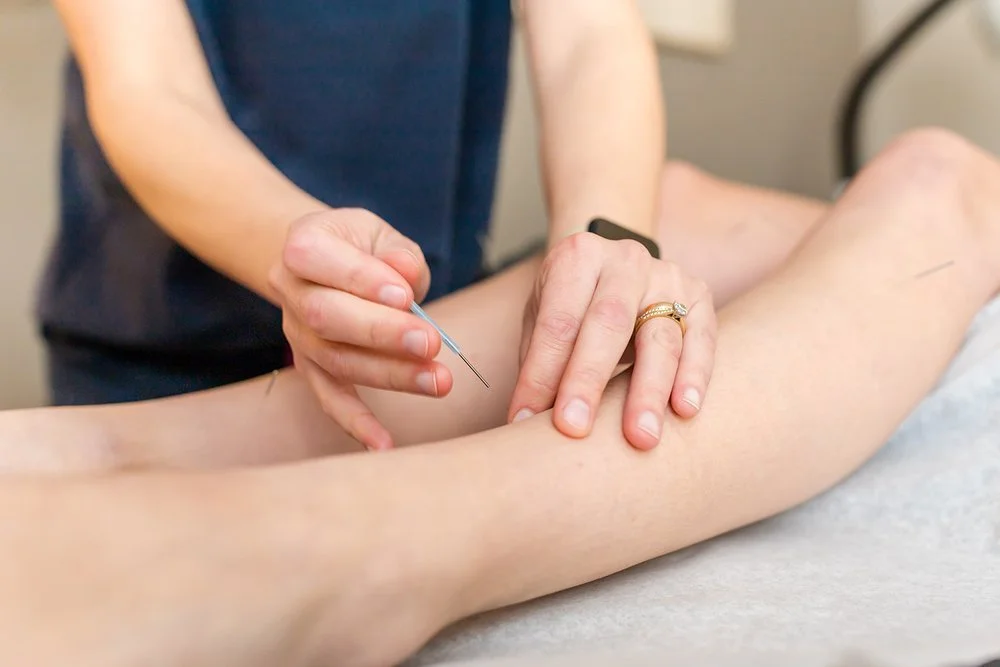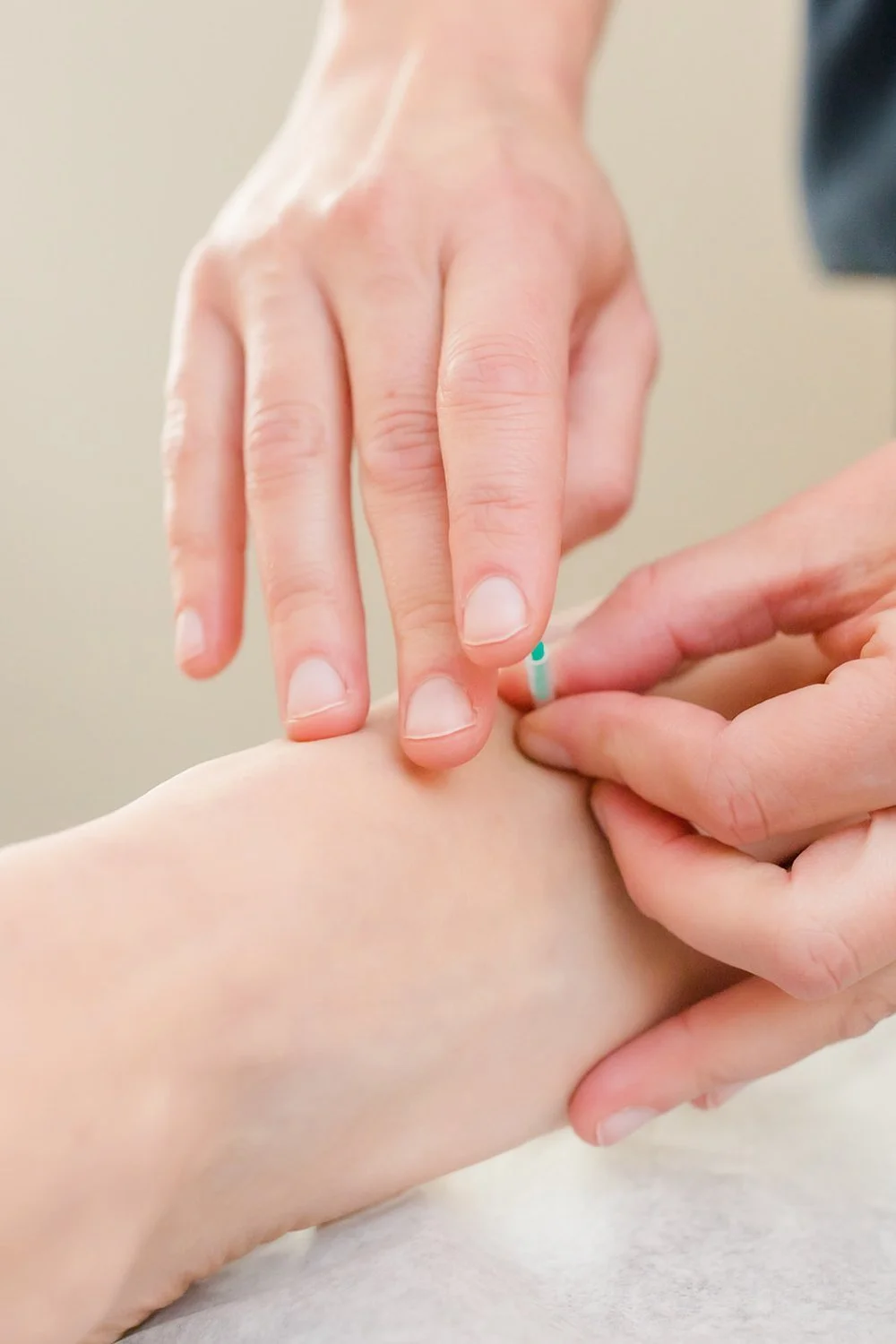Dry Needling
Dry needling is a technique used to treat trigger point pain and myofascial pain. Other terms commonly used to describe dry needling include Acupuncture, trigger point dry needling, and intramuscular manual therapy.

Conditions We Treat with Dry Needling
Back & Neck Pain
Stenosis
Facet Arthrosis
SI Syndrome
Sciatica
Shoulder Pain
Rotator Cuff
Labrum
Tennis / Golfers Elbow
Headaches
Migraine & Tension Type
More Conditions
Hip and Gluteal Pain
Knee Pain
Achilles Tendonitis/Tendonosis
Plantar Fasciitis
Sciatica
Muscular Strains/Ligament Sprains
Chronic Pain
Whiplash
TMJ
Athletic Performance
FREQUENTLY ASKED QUESTIONS
-
Dry needling is a treatment that uses thin needles to reduce muscle tension and pain. It's used by acupuncturists, physical therapists, athletic trainers, chiropractors, and physicians. We insert small, sterile filament needles into the skin and muscle directly at a myofascial trigger point. This generates a twitch response, helping release muscle tension and pain.
-
Active trigger points consist of multiple contraction knots within a muscle, and they can develop due to injury, musculoskeletal dysfunction and overuse. Active trigger points impair a person’s ability to lengthen, strengthen or contract the muscle. As a result, the muscle shortens and compresses the structure around it, causing pain.
-
Dry needling can be used to treat a variety of musculoskeletal issues, including: neck, back and shoulder pain; arm pain (tennis elbow, carpal tunnel, golfer’s elbow); headaches (migraines and tension-type); jaw and dental pain; buttock and leg pain (sciatica, hamstring strains, calf tightness/spasms).
-
Yes, dry needling is generally safe when performed by a licensed practitioner. The needles are sterile and disposable, and are typically not painful.
-
The needle used in the procedure is very thin and most patients don’t even feel it penetrate the skin. The twitch response usually elicits a very brief (less than a second) painful response. Some patients describe this feeling as a little electrical shock or cramping sensation. This twitch response is a positive and desirable reaction. Pain may also be felt in the referral zone, also and expected response to treatment.
-
Most patients report feeling sore following dry needling. Symptoms are usually described as sore muscles near the treatment area and in the areas of referred pain. Typically, the soreness lasts a few hours up to two days. Over this time, we may recommend applying heat or ice over the area, gentle stretching, and/or modifying your daily activities, depending on your individual response to the treatment and how sore you feel.
-
Patients typically notice a positive reaction within a few visits. The number of sessions needed depends on the severity of your symptoms.
-
Dry needling is generally safe for most people, but there are some situations where it might not be the right option. These include pregnancy, bleeding disorders, and fear of needles.
-
Yes and no. Technically, dry needling is different from acupuncture, which is based on traditional Chinese medicine while dry needling is based on modern medicine and muscles. However, there is a lot of crossover between the two!
-
Although the exact mechanisms of dry needling are not known, the technique has demonstrated both mechanical and biochemical effects. Pioneering studies by Dr. Jay Shah and his colleagues at the National Institutes of Health have shown that inserting a needle into trigger points can cause favorable biochemical change that can assist in reducing chronic pain issues.
Trigger points are known to have abnormal electrical activity and are surrounded by numerous chemicals known to cause inflammation. Research has shown that when a needle is successfully inserted into a trigger point and generates a local twitch response, over time, it can return the electrical and chemical environment within the muscle to its normal, relaxed state. Deactivated trigger points draw white blood cells and plasma cells into the area and create a healing response. Clinically, we see improved muscle length, strength, flexibility and a corresponding decrease in pain with our patients following dry needling treatment.
“I’ve been going to Elizabeth for almost two years now and I am in awww all the time. She’s amazing!!! So much years of pain and discomfort and she given me so much relief. The whole staff at SRAW are all awesome and friendly!!!
Thank you for the best experience every time!!”
JD — SACO, ME
HOW WE DO IT
We tap into the healing powers your body already has. And when you take a step back and think about it, that makes the most sense.
-
Quick & Painless
The procedure is quick and painless, you're in and out of the office in 30 minutes. The number of procedures you will need will vary based on your pain, injury, amount of time you've had it, etc.
-
Accurate Evaluation
Once you are evaluated, the doctor will determine based upon your clinical presentation a treatment plan and adjust as needed during the course of your care.
-
Process
The dry needling process is repeated 2-4 time a week until maximum improvement is seen. Then a maintenance regimen is often prescribed to prevent recurrence. Maintenance may be as ltitle as 1-2 times per month.
-
Pair with Acupuncture
Dry Needling Therapy is most effective when paired with Acupuncture Therapy simultaneously. Dry Needling can often results in a complete absence of symptoms, even in severe pain conditions that have been present for years.




